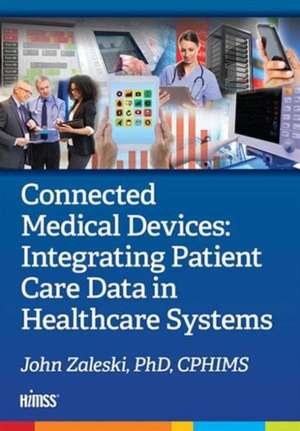Connected Medical Devices: Integrating Patient Care Data in Healthcare Systems: HIMSS Book Series
Autor John Zaleskien Limba Engleză Paperback – 27 mar 2015
The book begins with a comprehensive overview of the types of medical devices in use today and the ways in which those devices interact, before examining factors such as interoperability standards, patient identification, clinical alerts and regulatory and security considerations. Offering lessons learned from his own experiences managing MDI rollouts in both operating room and intensive care unit settings, the author provides practical guidance for healthcare stakeholders charged with leading an MDI rollout. Topics include working with MDI solution providers, assembling an implementation team and transitioning to go-live. Special features in the book include a glossary of acronyms used throughout the book and sample medical device planning and testing tools.
Din seria HIMSS Book Series
-
 Preț: 369.54 lei
Preț: 369.54 lei - 20%
 Preț: 1009.59 lei
Preț: 1009.59 lei -
 Preț: 259.76 lei
Preț: 259.76 lei - 8%
 Preț: 486.70 lei
Preț: 486.70 lei - 20%
 Preț: 265.82 lei
Preț: 265.82 lei -
 Preț: 389.59 lei
Preț: 389.59 lei - 5%
 Preț: 248.38 lei
Preț: 248.38 lei - 20%
 Preț: 457.61 lei
Preț: 457.61 lei -
 Preț: 366.52 lei
Preț: 366.52 lei - 5%
 Preț: 373.22 lei
Preț: 373.22 lei - 23%
 Preț: 399.72 lei
Preț: 399.72 lei - 5%
 Preț: 401.65 lei
Preț: 401.65 lei - 18%
 Preț: 911.44 lei
Preț: 911.44 lei - 23%
 Preț: 379.22 lei
Preț: 379.22 lei - 9%
 Preț: 936.25 lei
Preț: 936.25 lei - 25%
 Preț: 600.46 lei
Preț: 600.46 lei -
 Preț: 460.09 lei
Preț: 460.09 lei - 5%
 Preț: 372.50 lei
Preț: 372.50 lei - 22%
 Preț: 370.02 lei
Preț: 370.02 lei - 15%
 Preț: 490.17 lei
Preț: 490.17 lei - 15%
 Preț: 460.53 lei
Preț: 460.53 lei - 15%
 Preț: 495.19 lei
Preț: 495.19 lei - 31%
 Preț: 391.92 lei
Preț: 391.92 lei - 22%
 Preț: 387.99 lei
Preț: 387.99 lei - 26%
 Preț: 764.20 lei
Preț: 764.20 lei - 15%
 Preț: 558.47 lei
Preț: 558.47 lei - 31%
 Preț: 284.92 lei
Preț: 284.92 lei - 31%
 Preț: 286.90 lei
Preț: 286.90 lei - 17%
 Preț: 380.35 lei
Preț: 380.35 lei - 31%
 Preț: 466.73 lei
Preț: 466.73 lei - 15%
 Preț: 653.71 lei
Preț: 653.71 lei - 12%
 Preț: 343.55 lei
Preț: 343.55 lei - 31%
 Preț: 428.51 lei
Preț: 428.51 lei - 12%
 Preț: 343.55 lei
Preț: 343.55 lei - 18%
 Preț: 844.73 lei
Preț: 844.73 lei - 31%
 Preț: 467.44 lei
Preț: 467.44 lei -
 Preț: 466.45 lei
Preț: 466.45 lei - 29%
 Preț: 348.33 lei
Preț: 348.33 lei
Preț: 486.32 lei
Preț vechi: 628.40 lei
-23% Nou
Puncte Express: 729
Preț estimativ în valută:
93.05€ • 97.42$ • 76.100£
93.05€ • 97.42$ • 76.100£
Comandă specială
Livrare economică 17-31 martie
Doresc să fiu notificat când acest titlu va fi disponibil:
Se trimite...
Preluare comenzi: 021 569.72.76
Specificații
ISBN-13: 9781938904783
ISBN-10: 1938904788
Pagini: 234
Dimensiuni: 178 x 254 x 16 mm
Greutate: 0.5 kg
Ediția:1
Editura: Taylor & Francis
Colecția HIMSS Publishing
Seria HIMSS Book Series
Locul publicării:Oxford, United Kingdom
ISBN-10: 1938904788
Pagini: 234
Dimensiuni: 178 x 254 x 16 mm
Greutate: 0.5 kg
Ediția:1
Editura: Taylor & Francis
Colecția HIMSS Publishing
Seria HIMSS Book Series
Locul publicării:Oxford, United Kingdom
Public țintă
Professional Practice & DevelopmentCuprins
Introduction: Overview of Medical Device Interoperability (MDI) and the Current State of the MDI Industry, What is MDI and Why is it Needed Chapter 1: Medical Device Types and Classes Used and How They Communicate Chapter 2: MDI Solution Acquisition and Implementation Chapter 3: Semantic Data Alignment and Time Synchronization of Medical Devices Chapter 4: Standards Surrounding Medical Device Integration To Health Systems Chapter 5: Notifications, Alerts and Clinical Uses of Medical Device Data Chapter 6: Patient Identification and Medical Device Association Chapter 7: Regulatory and Security Considerations of MDI
Notă biografică
John Zaleski, PhD, CPHIMS, brings more than 25 years of experience in researching and ushering to market devices and products to improve healthcare. Dr. Zaleski received his PhD from the University of Pennsylvania, with a dissertation that describes a novel approach for modeling and prediction of post-operative respiratory behavior in post-surgical cardiac patients. Dr. Zaleski has a particular expertise in designing, developing, and implementing clinical and non-clinical point-of-care applications for hospital enterprises. Dr. Zaleski is the named inventor or co-inventor on seven issued patents related to medical device interoperability. He is the author of numerous peer-reviewed articles on clinical use of medical device data, information technology and medical devices and wrote two seminal books on integrating medical device data into electronic health records and the use of medical device data for clinical decision making.
Descriere
This book explores how medical device integration (MDI) supports quality patient care and better clinical outcomes by reducing clinical documentation transcription errors, improving data accuracy and density within clinical records and ensuring the complete capture of medical device information on patients. It begins with a comprehensive overview of the types of medical devices in use and the ways in which those devices interact, then examines factors such as interoperability standards, patient identification, clinical alerts and regulatory and security considerations.
